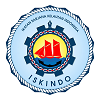Coral reefs eco tourism sustainability management In the Gili Labak Island using rapfish method
Abstract
The purpose of this research is to give direction of management of Gili Labak Island by considering multidimensional factors. The method used is Rapfish. This method uses the ecological, resource, economic, social, legal and institutional dimensions. Rapfish Gili Labak's analysis results for the ecological dimension show a value of 62.3 in a fairly sustainable category. The resource dimension shows a value of 63.07 in fairly sustainable categories. The economic dimension shows the value of 10.15 in the unsustainable category. the social dimension of value of 17.8 in the unsustainable category. Legal dimensions and institutional values of 5.36 in non-sustainable categories. Multidimensional analysis results show sustainability index in less sustainable category (value 34,24). After interference is increased it becomes quite continuous (value 74.99). This interference is described in the recommendations. Recommendations are made on the lesser dimensions, namely the legal and institutional fields, the economic field and the social field.
Full Text:
PDFReferences
Anwar, R. (2011). Pengembangan dan keberlanjutan wisata bahari di wilayah pesisir dan pulau-pulau kecil Kota Makassar.
Cissé, A. A., Blanchard, F., & Guyader, O. (2014). Sustainability of tropical small-scale fisheries: Integrated assessment in French Guiana. Marine Policy, 44, 397-405. http://dx.doi.org/10.1016/j.marpol.2013.10.003.
Muhsoni,F.F. (2015). “Pemetaan Terumbu Karang Pulau Gili Labek Dengan Metode Transek Foto Bawah Air Dan Citra Satelit LDCM Untuk Arahan Pemanfaatan Ekowisata.” In Seminar Nasional Kelautan, Bangkalan: UTM Press.
———. 2016. “Analisi Daya Dukung Pemanfaatan Pulau Gili Labak Dengan Menggunakan Sistem Informasi Geografis.” Seminar Nasional Perikanan dan Kelautan VI FPIK UB: 1–6.
Muhsoni, F.F., and Sofarini, D. (2016). “Manajemen Sumberdaya Perikanan Tangkap Di Kabupaten Sampang Dengan Menggunakan Metode Rapfish.” In Seminar Nasional Pengelolaan Sumberdaya Perikanan Pelagis Di Indonesia, Malang, 51–58.
Muhsoni, F.F., Syarief, M., and Effendy, M. (2011). “Inventarisasi Data Potensi Sumberdaya Wilayah Pesisir Kabupaten Sumenep Madura.” Jurnal Ilmu Keluatan, 4(1), 96–101.
Pitcher, T. J., and D. Preikshot. (2001). “RAPFISH: A Rapid Appraisal Technique to Evaluate the Sustainability Status of Fisheries.” Fisheries Research, 49(3), 255–70.
Suresha, A. M., Ananthan P.S., Ramasubramanian, V, and H.V. Divya Kumari. (2015). “Validating RAPFISH Sustainability Indicators: Focus on Multi-Disciplinary Aspects of Indian Marine Fisheries.” Marine Policy, 60, 202–7. http://linkinghub.elsevier.com/retrieve/pii/S0308597X15002006.
DOI: https://doi.org/10.21107/jk.v10i2.3235
Refbacks
- There are currently no refbacks.

This work is licensed under a Creative Commons Attribution 4.0 International License.

Jurnal Kelautan by Program Studi Ilmu Kelautan is licensed under a Creative Commons Attribution 4.0 International License.
Published by: Department of Marine Sciences, Trunojoyo University of Madura













